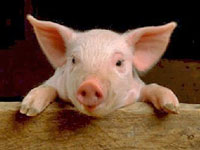
Believe it or not, UpToDate recommends honey as first aid for
button battery ingestions.
Perhaps we should look at the evidence.
We know button batteries can cause nasty and sometimes
lethal caustic oesophageal injury.
This study was a cadaver and live American Yorkshire piglet model
looking at potential pH neutralizing agents prior to definitive
endoscopy.
In vitro, they tested the final tissue pH of cadaver oesophagus
after installation of various products. They included different kinds of honey,
Carafate, apple juice, orange juice, Powerade, Gatorade, maple syrup, simulated
saliva and 0.9% sodium chloride control.
In the lab, the honey and Carafate seemed to work the best and
underwent further study.
Bring on the live pigs!
9 anaesthetised pigs had a button battery placed in their
oesophagus for an hour. (Poor creatures.) Serial irrigations of study solution
occurred every ten minutes starting at the five-minute mark.
2 pigs got honey,
3 got Carafate, and 4 got saline control.
On day 7, the unfortunate piglets were euthanized and
histology obtained.
Results?
Honey was the big winner! They had much less depth of
injury. Half of the saline piglets had delayed oesophageal rupture.
This little piggy went to market… to get honey! Give honey for
button battery ingestion.
Really??!!?
This recommendation is based on TWO anesthetised
pigs that got honey.
This is extremely low-quality evidence.
One should only change practice based on such low-quality
evidence if the treatment or therapy was considered to be extremely low risk.
Perhaps honey is extremely low risk. But are we certain?
Would care get delayed in finding and administering honey?
Does honey impair endoscopy? What about aspiration or honey induced
mediastinitis? Will kids get nasal-oesophageal tubes to administer honey? Would
we tend to delay endoscopy because they "got the honey?”
Perhaps risk may be minimal… But changing practice based on
two honey glazed pigs??
(ok… I’d give the
honey too… I can’t believe I just said that…)
Covering:
Anfang RR, Jatana KR, Linn RL, et al. pH-Neutralizing
Esophageal Irritations as a Novel Mitigation Strategy for Button Battery Injury.
Laryngoscope 2018 Jun 11. doi: 10.1002/lary.27312. [Link to article]
